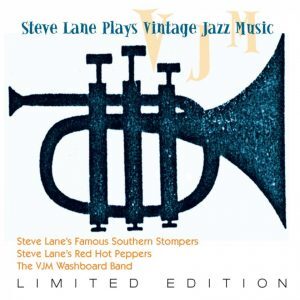The British trad movement of the 1950s and ’60s found dozens of jazz bands popping up throughout England. The music they focused on fell into three sometimes overlapping areas: “Pure” New Orleans jazz (as typified by Bunk Johnson and George Lewis), Chicago Dixieland bands in the vein of Eddie Condon, or explorations of 1920s/early ’30s jazz.
Trumpeter Mike Daniels and cornetist Steve Lane had several things in common. They were both ensemble-oriented players who provided a solid lead and laid-back solos. They both dug up gems from the 1920s and had them outfitted with new arrangements that fit the era. While their playing was consistently excellent, they were both “amateurs” in that they had nonmusical day jobs. And they are both subjects of recent Limited Edition releases from the British Lake label.
While the good folks at the Lake label (led since 1984 by Paul Adams) plan to cut back a bit and eventually retire, there is no reason that the classic jazz world cannot keep them busy in the meantime. Lake has released hundreds of valuable compilations from the British trad era and anyone interested in classic jazz should take a close look at their vast catalog.
 Although a part-time player, Steve Lane (1921-2015) was involved in many projects throughout his career including releasing rare early recordings on the VJM label. Unlike Daniels, he was on a fair number of recordings with his Famous Southern Stompers and (later in his career) The Red Hot Peppers. Lane had the ability to take a very obscure song from the 1920s (and even a few standards) and create a stirring version that topped the original.
Although a part-time player, Steve Lane (1921-2015) was involved in many projects throughout his career including releasing rare early recordings on the VJM label. Unlike Daniels, he was on a fair number of recordings with his Famous Southern Stompers and (later in his career) The Red Hot Peppers. Lane had the ability to take a very obscure song from the 1920s (and even a few standards) and create a stirring version that topped the original.
For example, he opens up “Copenhagen,” a semi-standard from the 1920s that is the opening selection on Steve Lane Plays Vintage Jazz Music The familiar theme is succeeded by four hot blues choruses, the theme resurfaces, and then the band jams seven more choruses, all but two (brief solos by clarinetist George Dawson and banjoist Nick Singer) being ensembles.
Lane’s playing throughout is quiet but purposeful. To give another example, “Shreveport Stomp” has traditionally been a clarinet-piano-drums showcase. After paying tribute to its heritage for the first minute, Lane and the rest of his band join in for some rollicking playing at a tempo faster than Jelly Roll Morton would have played it. The same thing happens on “The Chant” which really takes off.
has some of the highpoints of Lane’s career, spanning 1961-79 with two numbers from 1987. While most of the sidemen never became all-that-famous (pianist Ray Smith is best known), their musicianship is excellent and they knew this era well. They certainly make a case for such rarely-played numbers as “New Orleans Shuffle,” Ellington’s “Swampy River,” (the first band version of what was a piano solo) and Jabbo Smith’s “Sau-Sha Stomp” becoming standards. And the brief transformation of Morton’s “New Orleans Joys” into modern jazz during the piano solo is a witty surprise.
Steve Lane Plays Vintage Jazz Music (Lake LACD357, 19 selections, TT= 77:02)
Also read: Remembering Mike Daniels (Lake LACD356, 22 selections, TT = 78:33)
Since 1975 Scott Yanow has been a regular reviewer of albums in many jazz styles. He has written for many jazz and arts magazines, including JazzTimes, Jazziz, Down Beat, Cadence, CODA, and the Los Angeles Jazz Scene, and was the jazz editor for Record Review. He has written an in-depth biography on Dizzy Gillespie for AllMusic.com. He has authored 11 books on jazz, over 900 liner notes for CDs and over 20,000 reviews of jazz recordings.
Yanow was a contributor to and co-editor of the third edition of the All Music Guide to Jazz. He continues to write for Downbeat, Jazziz, the Los Angeles Jazz Scene, the Jazz Rag, the New York City Jazz Record and other publications.






















